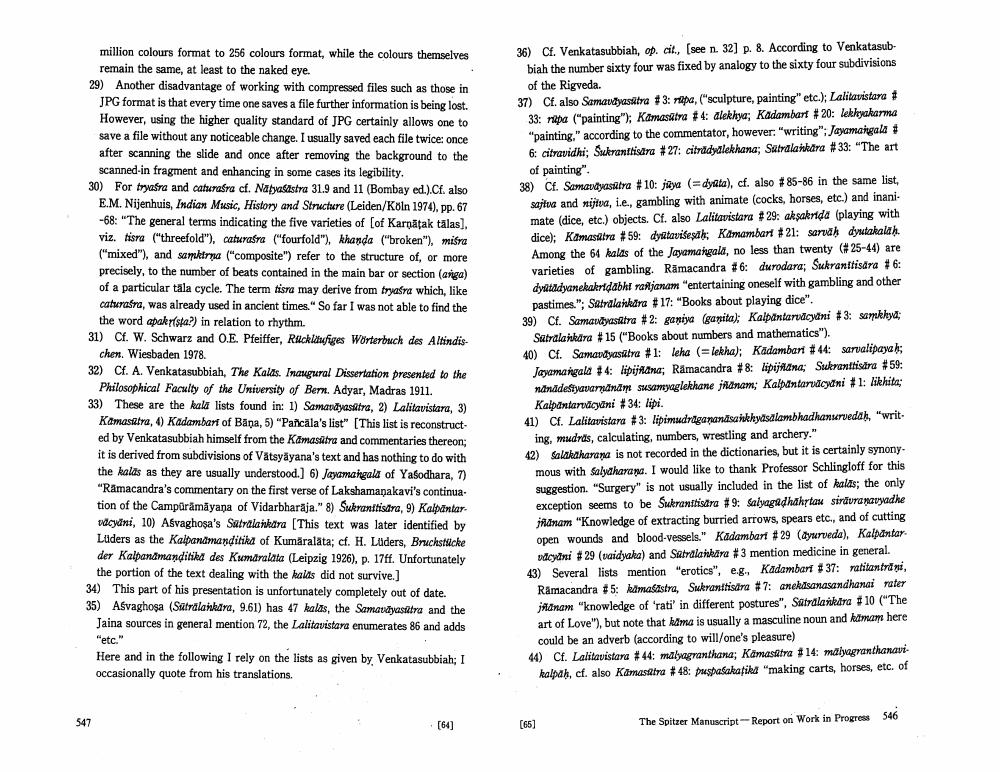Book Title: Spitzer Manuscript Report On Work In Progress Author(s): Eli Franco Publisher: Eli Franco View full book textPage 9
________________ million colours format to 256 colours format, while the colours themselves remain the same, at least to the naked eye 29) Another disadvantage of working with compressed files such as those in JPG format is that every time one saves a file further information is being lost. However, using the higher quality standard of JPG certainly allows one to save a file without any noticeable change. I usually saved each file twice once after scanning the slide and once after removing the background to the scanned-in fragment and enhancing in some cases its legibility. 30) For trafra and caturasra cf. Natastra 31.9 and 11 (Bombay ed.).Cf. also E.M. Nijenhuis, Indian Music, History and Structure (Leiden/Köln 1974), pp. 67 -68: "The general terms indicating the five varieties of (of Karnatak talas), viz. tisra ("threefold"), carafea ("fourfold"), khanda ("broken"), mira ("mixed"), and sapultru ("composite") refer to the structure of, or more precisely, to the number of beats contained in the main bar or section (anya) of a particular tala cycle. The term tisra may derive from tryasra which, like caturafra, was already used in ancient times." So far I was not able to find the the word aakrista?) in relation to rhythm. 31) Cf. W. Schwarz and O.E. Pfeiffer, Ruckläufiges Wörterbuch des Altindis chen. Wiesbaden 1978 32) Cf. A. Venkatasubbiah, The Kalas. Inaugural Dissertation presented to the Philosophical Faculty of the University of Bern. Adyar, Madras 1911. 33) These are the kala lists found in: 1) Samandysitra, 2) Lalitavistaru, 3) Kamasara, 4) Kadambart of Bana, 5) "Pancala's list" (This list is reconstruct ed by Venkatasubbiah himself from the Kamasite and commentaries thereon; it is derived from subdivisions of Vatsyayana's text and has nothing to do with the halas as they are usually understood.] 6) Jayanagala of Yasodhara, 7) "Ramacandra's commentary on the first verse of Lakshamapakavi's continua tion of the Campūrāmāyana of Vidarbharāja." 8) Suderantisdra, 9) Kalpanter sdcyani, 10) Asvaghosa's Satralandra (This text was later identified by Lüders as the Kaipandmanditika of Kumaralata; cf. H. Lüders, Bricksticke der Kalpandmanditik des Kumaralata (Leipzig 1926), p. 17ff. Unfortunately the portion of the text dealing with the halds did not survive.] 34) This part of his presentation is unfortunately completely out of date. 35) Asvaghosa (Satralankara, 9.61) has 47 kalas, the Samanthasitra and the Jaina sources in general mention 72, the Lalitavistara enumerates 86 and adds etc." Here and in the following I rely on the lists as given by, Venkatasubbiah; I occasionally quote from his translations. 36) Cf. Venkatasubbiah, op. cit., (see n. 32) p. 8. According to Venkatasub biah the number sixty four was fixed by analogy to the sixty four subdivisions of the Rigveda. 37) Cf. also Samawiyasitra #3: ripa, ("sculpture, painting" etc.); Lalitavistara # 33: ripa ("painting"); Kamastra #4: alekhya; Kadambart #20: lekhyakarma "painting, according to the commentator, however: "writing":Jayamalyala # 6: citravidki: Sukranttisara #27: citradyalekhana; Satrdlankara #33: "The art of painting": 38) Cf. Samaudyashtra #10: jaya (=dyta), cf. also #85-86 in the same list, sajt and nijtva, i.e., gambling with animate (cocks, horses, etc.) and inani. mate (dice, etc.) objects. Cl. also Lalitavistara #29: aksakrida (playing with dice); Kamasutra #59: dystavitesh: Kamambart #21: sarudh dyutakalah. Among the 64 balas of the Jayamaigala, no less than twenty (125-44) are varieties of gambling. Ramacandra #6: durodara; Sukranttisara #6: dyutadyanekakridabht raitjanam "entertaining oneself with gambling and other pastimes."; Satralankara #17: "Books about playing dice". 39) Cf. Samatyasiatra #2: ganiya (gamital: Kalpantarudcyani #3: samkhya; Satralankara #15 ("Books about numbers and mathematics"). 40) Cf. Samardyasitra #1: leha (=lekha); Kadambari #44: sarvalipayah Jayamangala #4: lipijnana; Ramacandra #8: lipijnland, Sukranttistra #59: nanddeftyavarnanam susamyaglekhane faldnam, Kalpantarudcyni # 1: likhita; Kalpantarãcyani #34: lipi. 41) Cf. Lalitavistara #3: lipimudragananasaikkuasalanbhadhanurvedar, "writ ing, mudrds, calculating, numbers, wrestling and archery." 42) Salakaharana is not recorded in the dictionaries, but it is certainly synony mous with Salyaharap. I would like to thank Professor Schlingloff for this suggestion. "Surgery" is not usually included in the list of Malas; the only exception seems to be Sukranitisara #9: Salyagadhahrtau sirduramayadhe anam "Knowledge of extracting burried arrows, spears etc., and of cutting open wounds and blood vessels." Kadambari + 29 (ayurveda), Kalpantar udrydni #29 (vaidyaka) and Satralaihdra #3 mention medicine in general. 43) Several lists mention "erotics", e.g. Kadambari #37: ratitantani, Ramacandra #5: hamasastra, Sukranttisdra #7: anekasanasandhanai rater jalanam "knowledge of 'rati' in different postures". Satralaskara #10 "The art of Love"), but note that kama is usually a masculine noun and laman here could be an adverb (according to will/one's pleasure) 44) Cf. Lalitavistara #44: malagranthana; Kamasutra #14: malyagranthanavi. kalpah, cf. also Kamasutra # 48: puspasakafika "making carts, horses, etc. of 547 The Spitzer Manuscript - Report on Work in Progress 546Page Navigation
1 ... 7 8 9 10
